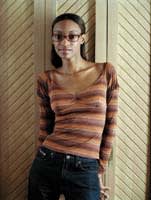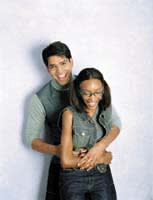|
|
|
|
Essence Eyewear style E5125 for Creative Optics, a division of Marcolin. Top by ABS |
RETAIL
Attracting the Ethnic Market
Why catering to African-Americans and
Hispanics is an investment in your future
By Marcy Bruch; Photography by
Peter Baker; Styling by Ionia Dunn Lee; Hair and Makeup Alicia Kochis
Models: Dee Bailey/Click; Sandy Dias/McDonald Richards
According to American Demographics magazine, Hispanics, African-Americans and other non-white ethnic groups will represent $860 billion dollars in spending power this year alone. Yet ethnic market advertising expenditures represent only two percent of more than $2 billion in domestic media ad spending. And while the 2000 Census reports that approximately 13 percent of the United States population is Hispanic and another 12 percent is African-American, the future of our nation�s ethnic landscape won�t be so black and white. The latest census data reveals the dominant racial category of tomorrow will not be White, Hispanic, Black, Asian, or Indian. It will be a mix of all the above.
Knowing that, it behooves optical retailers to understand how to appeal to the ethnic �minorities� that are fast becoming the mainstream.
Embrace their celebrations
And what better way to start understanding this market then by jumping in and celebrating a local ethnic event? That�s exactly what Richard Chavis, owner of Wizard of Eyes in New York City, did. Every year the city�s Puerto Rican Day parade takes place in June, and Chavis decorates his dispensary with Puerto Rican flags, streamers, and confetti. �My store is located in the heart of Spanish Harlem�on West 116th Street�so I try to honor the local community�s ethnic pride,� he says. Similarly, Aida Crespo, owner of Broadway Vision in Newark, N.J., is involved as a delegate for the state�s Puerto Rican Day Parade. So every year she raffles off a free eye exam, along with complimentary Cristina frames and lenses at a festival. �Not only is it a great public relations gesture, it shows that I�m attuned to my customers� sensibilities,� maintains Crespo.
Rebecca Cooper, co-owner of Omega Optical in Philadelphia, Penn., celebrates Black History Month by hanging photographs of famous African-Americans who wore glasses such as Malcolm X, Rosa Parks, and the first-ever black Supreme Court judge, Thurgood Marshall. Cooper also tries to stay on top of what eyewear the current black celebrities are wearing. �You�d be surprised at how many people come in here asking for the Alain Mikli frames Samuel Jackson wears, R. Kelly�s Christian Diors, and the Fendis Mary J. Blige wore in a video,� she notes.
|
|
|
|
Eyewear: Style 332 Golden Wood by EBX Optik |
|
We need more ethnic P-O-P!
Yet despite the celebrity advertising for eyewear, Cooper says that since there is so little P-O-P featuring black models, she�s had to take matters into her own hands. �Twice a year I ask a few of my customers to participate in a photo shoot that I organize myself,� says Cooper. �I choose customers as models because they�re real people that my clientele can identify with. The photographs make it easier for them to picture how they would look in a particular style, so it�s a great way to ease them into the frame selection process,� she adds. �Kenneth Cole, Essence, Polo Ralph Lauren, and Maurice Malone have given us some great posters with black models, but other than that, there�s not a lot out there,� she maintains.
Alyce Skinner, owner of Adair Optical in Fort Worth, Texas, agrees that manufacturers would do well to feature more models of color in their point-of-purchase material. �I�ve even called a few of my resources and told them that more ads and posters showcasing ethnic diversity would help me sell more of their product.�
|
|
|
|
On Sandy: Haay by Maurice Malone for Moja Designs. On Dee: Guess? Eyewear style GU1048 for Viva Intl. |
Habla Espa�ol?
When it comes to servicing the Hispanic market, having at least one person on staff who speaks Spanish is crucial. Martha Taberly, owner of Vision 20 20 in Miami, Fla., points out that virtually her entire work force is bilingual. �About 95 percent of my customers are Hispanic,� she says. �And many of the older Cubans simply feel more comfortable talking with a salesperson in their native language. I have a lens menu written in Spanish, and I try to offer brochures and promotional literature in Spanish whenever possible.�
The Fit Niche
Still, the advent of licensed brands like Maurice Malone, Essence Eyewear, Diahann Carroll, and Cristina indicate manufacturers recognize the ethnic market is not only viable, but also alive and well. �The advantage to carrying these brands is that they address the fit issues that are specific to these ethnic groups,� says Chavis of Wizard of Eyes. �For black men especially, I need 150 temple length and size 60 eye size. It�s an unwritten rule among all my reps that as far as ordering frames goes, the bigger, the better. So they know whenever a bigger frame is introduced within a collection I carry, it�s an automatic go.�
Cooper of Omega Optical agrees that for many African-Americans, temples need to be a little longer and bridges need to be wider. She says that Maurice Malone and Donna Karan offer a military style (straight) temple that fits
well because it allows for those extra few millimeters to reach over the ear. Cooper also finds that some customers tend to be better off with frames that have extended hinges.
�They don�t squeeze the head, and the frames fit more comfortably,� she says. �Kawasaki has been a great resource because they offer an extended hinge otherwise known as a long lug, so I can measure a customer and get a frame that�s custom fit. Nose pads can also be a tricky fit, so I recommend an adjusted saddle bridge with a bow temple,� she adds.
What styles sell
When it comes to frame colors and finishes, both Chavis and Crespo have observed that many Puerto Rican women prefer gold metal frames. �They like frames that match their gold jewelry,� says Crespo. �With Hispanic men, however, I find many are more concerned about how their skin will react to the metal of the frame. Many people in this community work in factories, so I�ve done very well with Timex T201 titanium frame because men don�t get rashes from the metal and it�s reasonably priced.�
Down in Miami, it�s a different story, according to Tabarly and Edward Beiner, who owns Purveyor of Fine Eyewear in the upscale Coconut Grove neighborhood. �Cubans tend to be very traditional here. They don�t want anything flashy. Gold does not sell well at all,� says Tabarly. �They prefer rich tortoises, and status brands always sell.� Beiner agrees. �I get a lot of South American tourists at my Coconut Grove store who want to make sure the logo of a brand is visible. The status brands hold a lot of power here. By contrast, my South Miami location�which is only two miles away�caters to the professional Hispanic community,� says Beiner. �They expect a higher level of service, and they care about exclusivity. We�ve waited on many of the Miami Latin powers that be, such as Gloria Estefan, some ex-mayors, and Miami Heat basketball players. They are not so much concerned about the name brand as they are about finding something that�s unique.�
When it comes to what sells among her black customers, Cooper of Omega says it�s often the trendier, the better. �I believe the ethnic market embraces trends faster than the white market, because the oversized shields are selling like hotcakes.�
|
|
|
|
|
|
Voids In The Market
Yet even with more frame manufacturers catering to the ethnic market, some dispensers claim there�s still some major voids that are crying to be filled. �What we�re missing is a children�s collection and geriatric line that�s targeted specifically to African-Americans,� maintains Frank Barnes Jr., co-owner of Drs. Barnes and Carter in Montclair, N.J.
Cooper believes there should be more cutting-edge name brands. �If FUBU launched an eyewear collection, I know it would blow out of my store doors,� she maintains.
�Manufacturers should realize that the ethnic population has significant dollars that they�re willing to spend on eyewear. All marketers have to do is take their needs into consideration.�
She concludes: �We�ve only been open for a year here in Philadelphia, but the store has been so successful, we�re already planning to open another higher-end location in the same area. Obviously, there was a void in the market, and we just happened to walk into it. Lucky for us, the niche fit perfectly.�







